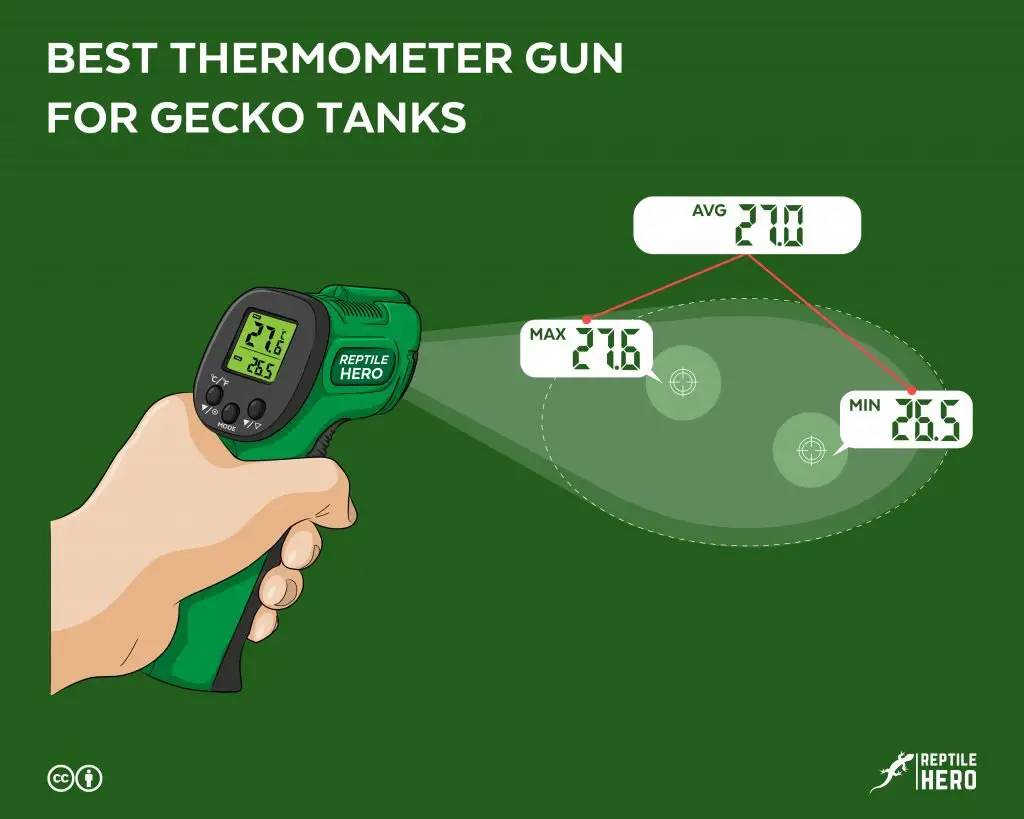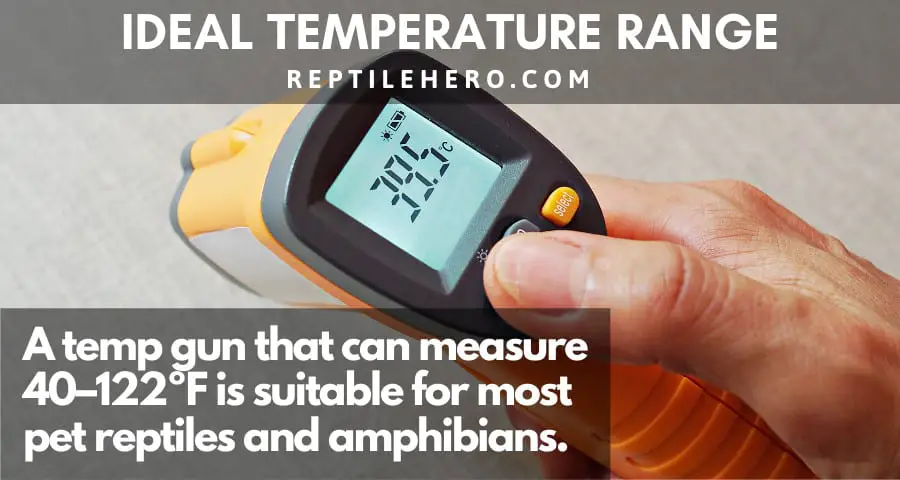Temperature Gun for Gecko Tanks? Find the Perfect One! (9 Factors)
How do you choose the best temperature gun for your gecko? Do non-contact laser thermometers even have any major differences among each other beyond aesthetics? The simple answer to that is yes.
Generally, gecko owners must assess a temperature gun according to
- Dimensions and weight: Smaller units are better but pen-type units are not suggested
- Laser guide: Lasers are essential for correct aim
- Emissivity setting: Adjustable emissivity is preferable but a fixed emissivity of 0.95 ε is also viable
- Response time: A reading speed of 0.50 seconds or less is the best
- Temperature range: Relatively limited ranges like -28–230ºF (-33–110ºC) are okay
- Distance-to-spot ratio: The optical resolution of 12:1 is the standard
- Battery required: Products with a long battery life will last you longer
- Display screen: A display screen needs to be big enough with legible data
- Buttons: It is best if all buttons are labeled with designated symbols for their functions
Materials have varying levels of emissivity so a temp gun with adjustable emissivity settings is a good find for gecko owners. But one with a fixed emissivity setting is still usable! Find out how by reading until the end.
Don’t have enough time to go through this buying guide right now? Head on to our list of recommended temp guns for gecko tanks for the best options, and then bookmark this article for later reading.

9 Factors in Buying Temperature Guns for Gecko Tanks
Not all thermometer guns are made equal. There are bad and good products. So in order to avoid wasting money, you should familiarize yourself with those few specifications that significantly affect how good a temperature gun is for your geckos’ needs.
1. Dimensions and Weight
A good handheld infrared (IR) temperature gun should be both small and light enough for gecko owners to comfortably hold onto and easily carry around.
Why does the size and weight matter? A good user experience, concerning dimensions and weight, can affect the willingness of keepers and breeders to regularly check on the tank temps of their reptiles.
If your arms get sore only after a few minutes of checking the temps in your pets’ enclosures using a bulky and heavy temp gun, you probably wouldn’t be excited to do so.
At the same time, though, a good reptile temp gun should still be big enough to spot, has a large enough screen for easy reading, and heavy enough that it wouldn’t be easily knocked over with a simple. Handheld temp guns like this one on Amazon are a perfect size.
My Take on Pen-Type Mini Temperature Guns for Gecko Tanks
The main appeal of pen-type mini temperature guns (here on Amazon) are, of course, their small size. They fit easily in pockets. So you can keep it with you even when you aren’t in your reptile room or anywhere near your geckos.
But honestly, that’s all there is to it. It doesn’t have any advantage over regular-sized IR thermal guns. Rather, this makes it easier to lose. In short, smaller is not necessarily better.
You get less than your money’s worth. Because these things are typically in the same price range—if not more expensive—than regular non-contact temp guns, you might expect more in terms of functionality and quality. But you’d be sorely disappointed.
From my observation and experience, pen-type IR guns are a lot less accurate and reliable too. They also normally have low distance-to-spot ratios so you would need to hold them as close as possible to whatever it is that you need to measure. (I will discuss this in more detail in a later section.)
2. Laser Guide
Ideally, a temperature gun used for reptile husbandry should have at least 1 laser guide. This laser pointer ensures that a gecko keeper is precisely measuring the surface temperature of his or her target and nothing else.
Many beginner gecko keepers mistakenly think that the laser guides affect the temp reading of a non-contact laser thermometer gun. However, this is not true per se.
In reality, the laser pointer found in most temp guns only tells you whether you are pointing exactly on your target or you are way off the mark. A sole laser typically points to the center or one edge of the 1-inch spot you are reading. Conversely, dual lasers commonly point to the opposite points of the spot’s diameter.
Additionally, it can help gecko parents figure out whether or not they are correctly holding it at the right angle.
Remember: The thermal gun must be positioned perpendicularly to the surface or object you are intending to check for temperature.
For example, if you want to check the surface temperature of your gecko’s basking tile, the thermometer should be precisely perpendicular to the flat surface—with the lens directly facing the surface.
You can’t use it at any other angle from across the room. You need to go and stand directly in front of it and have the temp gun right on top of it for accurate readings.
Wondering why your gecko follows the laser around?
Find out why they do this in our article on geckos and laser beams. Also, keep in mind that the laser on temp guns should never be pointed towards the eyes of your pet reptiles.
3. Emissivity Setting
An infrared temp gun with adjustable emissivity is preferred over models with fixed settings. This enables gecko owners can accurately check the temperature of various objects within the tank. Common tank materials (e.g., substrate, decors, furnishings) have emissivity ranging from 0.70 to 1.00 ε, averaging at 0.85 ε.
Yes, you read that right. The accuracy of a thermometer gun’s temperature readings of different materials is largely affected by and dependent on their specific emissivity.
But what exactly does emissivity even mean?
Emissivity (ε) refers to the ability of any material or object to emit infrared energy. This can range from 0 ε to 1 ε. A reflective item such as a mirror has 0 ε but a blackbody has an emissivity value of 1 ε.
Aside from reflectivity, factors that affect the emissivity of any material include color and texture. Light-colored and glossy materials generally have low emissivity. Conversely, dark-colored and matte or rough materials have high emissivity.
If you quickly check on your tank, most objects probably belong to the latter group except for fake and real plants. Meaning, gecko keepers and breeders should go for a temp gun with a fixed emissivity value that is higher on the scale.
The table below contains the average emissivity values of different materials, including objects which can be found in gecko tanks.
| Material | Average Emissivity (ε) |
| Polished Metal | 0.096 |
| Gravel | 0.280 |
| Aluminum Paint | 0.450 |
| Red Clay Tile | 0.455 |
| Carbon Filament | 0.530 |
| Oxidized Metal | 0.572 |
| Insulation Foam | 0.600 |
| Natural Concrete Tile | 0.625 |
| Glass-Ceramic | 0.710 |
| Fiberglass | 0.750 |
| Black Oxidized Copper | 0.780 |
| Anodized Aluminum | 0.785 |
| Wood | 0.814 |
| Cloth | 0.825 |
| Brown Concrete | 0.850 |
| Shiny Black Paint | 0.880 |
| Rubber | 0.895 |
| Sand White Paint Lacquered Enamel | 0.900 |
| Plywood | 0.905 |
| Earthenware | 0.915 |
| Ceramic Porcelain PVC | 0.920 |
| Glass Black Concrete | 0.925 |
| Rough Quartz White Plaster | 0.930 |
| Oil Paints (all colors) Rough Concrete | 0.940 |
| Common Brick Soil or Earth | 0.945 |
| Water | 0.953 |
| Granite Human Skin | 0.960 |
| Electrical Tape Ice Slate Tile | 0.970 |
| Optical Black Paint | 1.000 |
What emissivity value is most common non-contact infrared temp guns fixed at?
Non-contact infrared temp guns commonly have the emissivity fixed at 0.95. Though adjustable emissivity (here on Amazon) is better, this value is considered a good emissivity setting for reptile keeping. This fixed setting can accurately measure the surface temperature of tank materials such as soil and brick decors.
4. Response Time
Select a laser temperature gun with a quick response time so that the readings you get in gecko tanks are both timely and accurate. Preferably, the response time of a good thermometer gun is less than 1 second (100 ms).
The response time is also sometimes called the reading speed of the non-contact infrared thermal gun.
Stay with me on this one. I know that this factor may sound very superficial. But I can assure you that there’s a legitimate reason for this recommendation.
Think about it, if your temp gun has a slow response time, you will have to hold it for a much longer time as well. Now, if you have a really large collection of reptiles in your care, you would also need to do this multiple times a day.
In the long run, that’s quite a waste of time. Instead of only needing a few minutes to check on your tank temps, you could easily have to put aside at least 1 hour to cover all your vivariums.
5. Temperature Range
Gecko breeders and keepers do not necessarily need a thermometer gun with a wide temperature range if they only want to measure the materials in their tanks. However, having a temp gun with a relatively expansive range can be used to also check on equipment like heat lamps.
Quite honestly a temperature range of 40–122ºF (4.44–50ºC) is more than enough to cover the thermal needs of most, if not all, captive reptiles, like geckos and snakes.

This seemingly limited range will help provide pet reptiles with a realistic and naturalistic environmental temperature. It can help you keep an eye on thermal gradients throughout the year, including winter-time brumation temps. You could also use it to check on eggs you are incubating.
So you don’t really need to buy a non-contact laser thermal gun that has a temperature range starting way below the freezing point (32ºF or 0ºC) and ending way beyond the boiling point (212ºF or 100ºC) of water at sea level.
That’s quite an overkill. Unless you are planning to use your reptile tank temp gun for other purposes (e.g., industrial applications), you don’t need a model with a maximum temperature readout of 1472ºF or 800ºC (here on Amazon).
Picking high-temp thermometer guns for reptile-keeping will only cost you more than necessary. But if you really want a high-temp thermometer gun, you can find affordable units like this one on Amazon if you search hard enough.
How much do regular handheld infrared temperature guns cost?
The price of regular handheld infrared temperature guns ranges from approximately 20 to 40 dollars. In comparison, premium non-contact laser thermometers can cost you anything between 40 bucks to 1 grand—or more.
6. Distance-to-Spot Ratio
For less intrusive temperature reading in gecko tanks, a thermometer gun with a distance-to-spot ratio of 12:1 is recommended. This means that a reptile owner can get accurate 1-inch spot readings from a height or distance of 12 inches (30 cm). In general, a higher D:S ratio is ideal for larger tanks.
One of the main factors that will determine if an infrared temperature gun is appropriate for gecko-keeping is its distance-to-spot ratio.
This value is also referred to as the D:S ratio, optical resolution, or field of view (FOV), interchangeably.
How large of a surface can you get temperature readings for using an infrared temp gun?
Again, this will depend on the D:S value and the distance between the temperature gun and your target. The closer you get to your target, the smaller the surface area you can measure with the non-contact thermometer. Conversely, the farther away you are from your target, the larger the area you can get temperature readings for.
To save you some time with all the calculations, refer to the table below for a quick guide on D:S ratios and spot sizes according to different distances.
| D:S Ratio (in:in) | FOV (in2) @ ¼ ft | FOV (in2) @ ⅓ ft | FOV (in2) @ ½ ft | FOV (in2) @ 1 ft | FOV (in2) @ 2 ft | FOV (in2) @ 3 ft |
| 1:1 | 3.000 | 4.000 | 6.000 | 12.000 | 24.000 | 36.000 |
| 6:1 | 0.500 | 0.666 | 1.000 | 2.000 | 4.000 | 6.000 |
| 8:1 | 0.375 | 0.500 | 0.750 | 1.500 | 3.000 | 4.500 |
| 10:1 | 0.300 | 0.400 | 0.600 | 1.200 | 2.400 | 3.600 |
| 12:1 | 0.250 | 0.333 | 0.500 | 1.000 | 2.000 | 3.000 |
| 24:1 | 0.125 | 0.166 | 0.250 | 0.500 | 1.000 | 1.500 |
| 60:1 | 0.050 | 0.066 | 0.100 | 0.200 | 0.400 | 0.600 |
A Realistic Example
In short, when it comes to selecting the right D:S ratio for your gecko tanks you need to ask yourself two questions:
- How far—or how high—can I go to measure my target inside the tank?
- How big is the surface area of my target in the tank for precise temp readings?
For example, if you have a 4’x2’x2′ Wood Panel Reptile Enclosure by Zen Habitats, you can only go about 20 inches from the substrate without having to remove the steel mesh top. Besides that, find out the surface area of the smallest object you need to measure in the enclosure. Let’s say that target has a surface area of 1 in2.
Altogether, this means that the perfect choice for you is a temp gun with a D:S ratio of 10:1.
If you get one with a lower resolution, say 1:1, you would need to hold your thermal gun 2 inches away from the 2 in2 targets. Any father than that and you will be getting a reading that’s either higher or lower because of the other objects that have been included in the field of view.
7. Battery Required
Although a thermometer gun does not to be in operation continuously and without break for gecko owners to use it optimally for tank temp readings, it should still have relatively long battery life.
Number of Batteries Required
The battery required to operate a temp gun must be cost-efficient, in that it requires fewer replacements in the long run. You should also take into consideration how many batteries you need for it to work.
Chemistry of the Battery
Non-contact infrared thermometer guns generally require 2 types of batteries based on their chemistry:
- Alkaline—shelf life of up to 10 years
- Lithium—shelf life of up to 20 years
Other types based on chemistry include carbon-zinc, nickel-cadmium (Nicad or NiCD), and nickel-metal hydride (NiMH).
Shelf Life and Lifespan of the Battery
Shelf life and lifespan are entirely different things. Shelf life merely refers to the total time you can keep a battery in storage before it runs out of juice. On the other hand, lifespan refers to the actual time you can use the battery to power a device.
Depending on their specific sizes, these batteries have varying lifespans. Below are the common battery sizes suitable for powering a temperature gun:
- 9V DC
- A
- AA (2A)
- AAA (3A)
- C
- CR2
- CR123A
- CR2032
- LR41
- LR44
To put things into perspective, a lithium 9V battery has a lifespan of 10 hours if you use it to its fullest continuously. In comparison, an alkaline or NiMH 9V battery can only last for approximately 4 hours [1].
8. Display Screen
Generally speaking, the average display screen of thermometer guns is made of an LCD panel that is at least 1 in2 to show pertinent information (e.g., the surface temperature measured). Any smaller than that and gecko owners are likely to have a hard time reading the data on the screen.
The most important information displayed here is the real-time temperature reading of your target (e.g., basking tile) which you can—ideally—set to either Celsius or Fahrenheit.
Other details displayed on a temperature gun’s display screen include:
- Backlight Indicator (On/Off)
- Laser Indicator (On/Off)
- Alarm (On/Off)
- Hold or Scan
- Emissivity Setting (ε)
- Average Temperature
- Minimum Temperature
- Maximum Temperature
- Battery Life
- Time
It’s not common for regular non-contact infrared thermometer guns to have all 10 information displayed on their screen because they are normally quite small—around 1 in2. All this information isn’t necessary.
Nevertheless, they can help gecko owners determine if the temperature gun is functioning properly and set accordingly (e.g., ε=0.95 for the substrate or slate tile) for accurate readings.
Lastly, you should all consider where the display is placed. A temp gun that has a good design would traditionally have the display screen positioned opposite the laser hole and IR sensor/lens.
With such a design, you can easily read the temperature while pointing your thermometer towards your target.
9. Buttons
For a good user experience among gecko keepers and breeders, an infrared laser temperature gun should have multiple buttons that control different settings or functionality. Having only 1 button to control and change multiple settings can be time-consuming and confusing.
Here are the common types of buttons built into a temperature gun:
- Measurement Trigger
- Scan Button
- Celsius/Fahrenheit Button
- Set Button
- Mode Button
- Up Button
- Down Button
- Backlight Button
- Laser Button
Conventionally, only four buttons are in each temp gun: the 1) trigger/scan, 2) ºC/ºF, 3) backlight/laser, and 4) set/mode button. Other functions may also be controlled by specific buttons.
Unfortunately, these buttons aren’t always labeled or printed with a symbol for all the functions it can control. So make sure to familiarize yourself with what each button does from reading the user manual from start to finish.
Finally, also test out whether or not the buttons are easy to press on and if the temp gun responds quickly after any button is pressed.
Further Questions
Is it okay to only have a temp gun to monitor gecko tanks?
No, this is not advisable, especially in cases where gecko owners are taking care of multiple geckos. Although having a single non-contact IR temp gun will cost much less, it can only be recommended for temporary situations. In the long run, keepers and breeders should not only have temp guns but also dedicated ambient thermometers in each reptile enclosure.
Should my ambient thermometers and temperature guns give out the same reading?
No, they should not. If the temperature readings of your ambient thermometer and temperature gun are the same, one of them is likely defective or broken. On average, the surface temperature you get using a laser thermometer should be higher than the air temperature measured by your ambient thermometers.
What can affect the accuracy of a thermometer gun’s temperature reading?
Several things can affect the accuracy of a thermometer gun’s temperature readings besides emissivity, D:S ratio, and distance from the target. A dirty and/or scratched infrared lens, steam, fog, dust, and extreme or sudden change in weather/environment can also produce inaccurate readings.
Summary of the Perfect Temperature Gun for Gecko Tanks
Not all thermometer guns available in the market is appropriate for reptile keeping. Gecko owners need to assess a temp gun’s overall size, laser, emissivity, response time, temperature range, distance-to-spot ratio, battery, display screen, and buttons, in particular.
The aforementioned factors not only impact the accuracy of the surface temperature read-outs of a thermometer gun. All 9 factors also significantly affect the user experience. A good temp gun must be easy to use and cost-effective for gecko keepers and breeders.

![Do Geckos and Reptiles Dream in Their Sleep? [What Science Says]](https://www.reptilehero.com/wp-content/uploads/2021/07/Gecko-Sleeping-Infographic-768x614.jpg)




